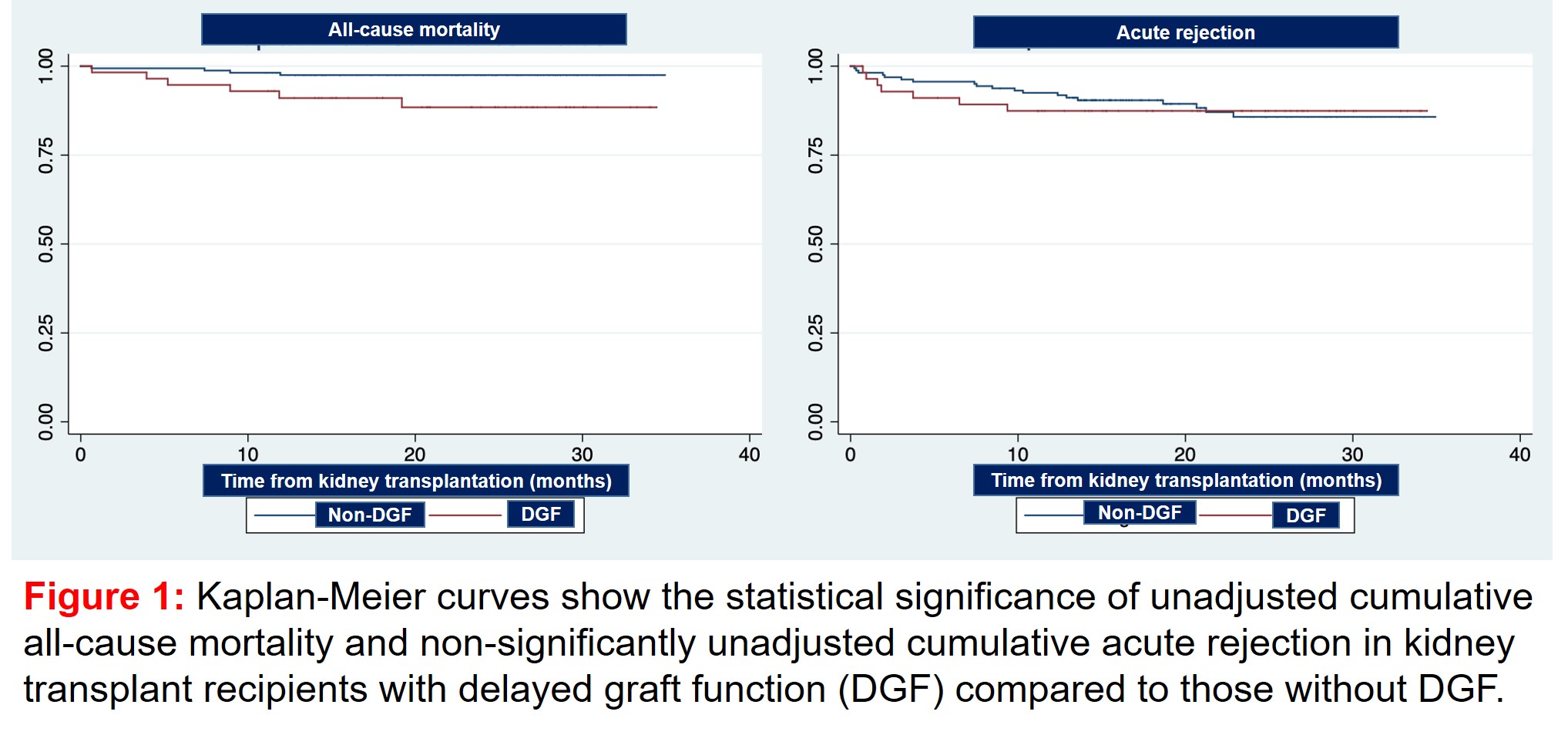Association of Delayed Graft Function with Mortality Post-kidney Transplantation
N. Eguchi1, H. Ichii2, F. J. Ferrey1, U. G. Reddy1, D. C. Dafoe2, H. Seo3, K. Kalantar-Zadeh1, E. Tantisattamo1
1Division of Nephrology, Hypertension and Kidney Transplantation, Department of Medicine, University of California Irvine, Orange, CA, 2Division of Kidney and Pancreas Transplantation, Department of Surgery, University of California Irvine, Orange, CA, 3School of Pharmacy and Pharmaceutical Sciences, University of California Irvine, Irvine, CA
Meeting: 2021 American Transplant Congress
Abstract number: 895
Keywords: Graft failure, Kidney, Kidney transplantation, Mortality
Topic: Clinical Science » Kidney » Kidney: Cardiovascular and Metabolic Complications
Session Information
Session Name: Kidney: Cardiovascular and Metabolic Complications
Session Type: Poster Abstract
Session Date & Time: None. Available on demand.
Location: Virtual
*Purpose: Given the ongoing shortage of donated organs, marginal kidneys with a higher possibility of delayed graft function(DGF) have been increasingly utilized. While DGF in kidney transplant recipients(KTR) is associated with acute kidney allograft rejection, its association with mortality is unclear.
*Methods: A single-center retrospective cohort study of consecutive KTR was conducted over 2 years. DGF was defined as a dialysis requirement within 7 days post-transplant. With the study population divided into DGF and non-DGF groups, an association between DGF and all-cause mortality were examined by multiple Cox proportional hazard regression analysis. Competing risk analysis was performed to determine the association of DGF with acute rejection by using mortality as a competing risk variable.
*Results: Of all 219 KTR, mean age±SD was 50±13 years and 123 patients (56%) were male. The majority were White(45%) followed by Asian(20%) and Black (2%). Up to 87 patients(40%) had diabetes and 26% had coronary artery disease. During a median follow-up of 22.2 months(0.63, 34.93), incidence rates of all-cause mortality and acute rejection were 0.002 and 0.006 person-months, respectively. Among 10 patients who died during the follow-up period, 6 patients (60%) were in the DGF group (p 0.012); whereas, only 7 out of 26 patients (27%) with acute rejection had DGF (p 0.871). Compared to the non-DGF group, the DGF group had 4.4 times greater mortality risk (HR 4.39, p 0.022, 95% CI 1.24, 15.55; Figure 1). After adjusted by age, gender, body mass index, former smoking, presence of pre-transplant diabetes, coronary artery disease, stroke, type of deceased kidney donors, the DGF group still had a significantly higher risk of death (HR 4.39, p 0.034, 95% CI 1.12, 17.22). However, DGF was not associated with acute rejection from unadjusted and adjusted competing risk analyses (HRunadjusted 1.05, p 0.910, 95% CI 0.44, 2.55 and sub-HRadjusted 1.35, p 0.515, 95% CI 0.55, 3.30).
*Conclusions: While DGF was an independent risk of mortality post-transplant, it was not associated with acute rejection. Non-immunological factors may play a role in poorer survival in KTR who developed DGF. Mechanism and risk factors of mortality in patients with DGF require further studies.
To cite this abstract in AMA style:
Eguchi N, Ichii H, Ferrey FJ, Reddy UG, Dafoe DC, Seo H, Kalantar-Zadeh K, Tantisattamo E. Association of Delayed Graft Function with Mortality Post-kidney Transplantation [abstract]. Am J Transplant. 2021; 21 (suppl 3). https://atcmeetingabstracts.com/abstract/association-of-delayed-graft-function-with-mortality-post-kidney-transplantation/. Accessed December 14, 2025.« Back to 2021 American Transplant Congress

